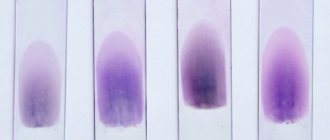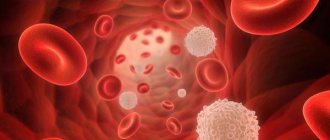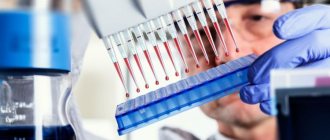Previously, this question could be answered very simply. How does a general blood test differ from a biochemical one? For a general analysis, blood is taken from a finger, and for a biochemical analysis, from a vein. Of course, such an answer was far from complete, but it told the patient perfectly about what was to come. Currently, a general analysis is also often taken from the peripheral, ulnar vein, and this definition has lost all meaning. So how does a clinical blood test really differ from a biochemical one (sometimes the general analysis is called clinical). In order to understand the difference in the tests, it is worth remembering what blood is.
A little about blood
Human blood is a special tissue that is liquid and adapted to perform many functions. We will not list all the functions; we will focus on just two as an example. One of the main functions of blood is gas exchange. It transports cells enriched with oxygen to organs and tissues, and takes from them the waste product of tissue respiration - carbon dioxide. Blood saturated with carbon dioxide is dark and venous. It rushes into the lungs, into the pulmonary circulation, where it is saturated with oxygen. Oxygenated blood is arterial; it flows through arteries, and gas exchange occurs in capillaries - the thinnest vessels.
The second function is transport. This unique liquid tissue transports a large number of different substances, molecules and compounds. The difference between these two functions is that the first is provided by cells, or red blood cells. And the second function does not require carrier cells. There are simply various dissolved substances in the blood - molecules, proteins, hormones, various ions. If carriers are needed, they are not cells, but special protein molecules that are millions of times smaller than cells.
If you take whole blood from a vein (or from a finger, from an ear, from a baby’s heel) and place it in a test tube and spin it for several minutes on a laboratory centrifuge, the blood will separate into two parts unequal in volume. At the top there will be a clear opalescent liquid, or plasma. It does not contain any cellular elements, but only dissolved substances and various compounds.
There will be a dark precipitate at the bottom of the tube. This is a cellular composition: red blood cells, leukocytes and platelets. Accordingly, a general analysis studies the properties of blood as a liquid, its physical characteristics, as well as its cellular composition. When conducting a general analysis, everything that is dissolved in the blood and found in its plasma is not taken into account at all. Let us briefly consider what studies are carried out after taking a standard general or clinical blood test.
What kind of research is this?
What is a clinical blood test and complete blood count? The answer is simple - the most common studies that cover parameters that allow the doctor to judge the condition of the body.
There are “formed elements” in the blood, which perform basic functions. There should be an amount of each particle depending on the age and gender of the person. If they go beyond the limits, then this indicates that something in the body is not happening as it should.
This analysis is indispensable in the treatment of colds. Often, when characteristic signs appear, a person does not go to the hospital, but goes to the pharmacy, buys an antiviral and takes unnecessary pills, develops complications and goes to the hospital with a “bunch of troubles” that are not easy to cure. The CBC will determine whether bacteria or viruses are to blame for the illness. So what is the difference between clinical and general blood tests?
What is examined during a general clinical analysis?
First of all, the total number of all cellular elements, red blood cells, leukocytes and platelets is determined. Red blood cells carry out gas exchange, white blood cells perform a protective function, and platelets regulate coagulation. When studying general analysis, it is very important to know the ratio of the amount of plasma, that is, the colorless part that does not contain cells, to the total volume. This indicator is called blood density, or hematocrit. With dehydration and fluid deficiency it is high, and with a lack of cells it will be low.
Previously, the color index was studied, but now the hemoglobin concentration is directly determined. It is very important for finding the causes of anemia.
The next very important indicator is ESR, or erythrocyte sedimentation rate. ESR is the first and easiest way to diagnose that there is some kind of inflammatory process in the body. The higher the ESR, the heavier the red blood cells and the faster they settle to the bottom of the tube. Their mass increases because they “cling” to their membrane a lot of different molecules, and also form various aggregates among themselves. Various proteins that are responsible for inflammation change the electrostatic parameters of red blood cells and reduce their repulsion from each other. Such cells are attracted to each other and quickly settle to the bottom. Thus, we can tentatively talk about some kind of inflammatory process. Also, a high ESR is characteristic of malignant neoplasms.
Currently, laboratory technology makes it possible to determine many erythrocyte indices. These include the average volume of a blood cell and the determination of its size. Modern laboratory technology makes it possible to determine the amount of hemoglobin in a red blood cell and the hemoglobin concentration. Separately, the processor of the laboratory analyzer will allow you to distribute red blood cells according to their size, or size. All these studies are automated and included in the overall analysis; they do not need to be ordered separately. Red blood cell indices and cell characteristics are very important in the presence of anemia, or a lack of hemoglobin in red blood cells. They help make the correct diagnosis.
Also, when studying the general analysis, attention is paid to what types of white blood cells, or leukocytes that protect us, are represented. In a standard analysis, the leukocyte formula is calculated. Currently, the study is carried out automatically using an analyzer. But still, the most popular is the manual examination of a stained and fixed blood sample under a microscope.
Among leukocytes, 5 subpopulations are distinguished. These are neutrophils that directly destroy foreign microorganisms and engage in phagocytosis, or their absorption. These are eosinophils that take part in allergic reactions and respond to helminthic infestations. These are lymphocytes that take part in immune reactions, these are monocytes, which are often found not only in the blood, but also in tissues as macrophages, as well as basophils. Such names come from the ability of leukocytes to perceive various dyes: neutral, basic and acidic.
A lot can be said from the leukocyte formula. Thus, an increase in white blood cells, regardless of their type, indicates inflammation, intoxication, various injuries, and stress. They increase in malignant neoplasms, including leukemia. A low white blood cell count occurs with anemia, autoimmune diseases, some chronic infections, and an enlarged spleen. Thus, how does a clinical blood test differ from a biochemical one? The study of the cellular composition and general properties of blood as a tissue.
There are some other research methods that also relate to a general or clinical blood test. For example, this is a study of reticulocytes. This is the name given to young red blood cells that have not yet been freed from the remnants of the cell nucleus. Their study is needed to indirectly assess bone marrow function and monitor the course of anemia.
All of the above studies relate to the so-called hematological studies. Hematology is a science that studies blood as a collection of different cells. Hematologists deal with anemia and leukemia, but in any case, the morphological substrate will be various normal or pathological cells, both in the peripheral blood and in the bone marrow. There are, of course, other studies in hematology. This is a determination of blood group and Rh factor, as well as a study of blood clotting ability, or coagulogram. But these methods can no longer be classified as general analysis. How does a biochemical blood test differ from a general blood test?
Blood test with leukocyte formula
White blood cells form an important part in the body, protecting it from harmful bacteria and substances. They ingest and disarm foreign particles. Consequently, the behavior of these cells can indicate the presence of an inflammation process, because the composition of the blood shows the state of human health. Therefore, for diagnostics that provide results on the number of leukocytes in the blood, a special test is prescribed, which is used in medicine called the leukocyte blood count. Judging by its results, you can find out about the type of disease, predict its course and predict the further outcome. What can a general blood test for leukocyte formula show?
Biochemical analysis, "biochemistry"
Let's remember: when we centrifuged whole blood, it was divided into two fractions: a cellular sediment and a large amount of light, opalescent, almost transparent liquid, in which there are no cells or other large structures. It's called plasma.
Any biochemical analysis (and there are a large number of them) deals only with plasma. The concentration of the desired substance is determined. Biochemists do not care about blood cells - red blood cells, leukocyte platelets, cell sedimentation rate, hemoglobin, color index and other cell-related parameters. The difference between a general blood test and a biochemical one is the study in the first case of blood cells and its general properties as a whole tissue.
During biochemical analysis, various substances or molecules dissolved and transported by plasma are examined. Among the standard biochemical indicators, the following, the most commonly used, can be identified:
- Glucose, or blood sugar. This is the most important indicator of carbohydrate metabolism, and the very first and simplest analysis that shows diabetes mellitus, or other endocrine diseases, pathology of the pancreas;
- A general protein that performs a large number of different functions. Plasma contains several different protein fractions, but total protein is the most basic and general indicator. It maintains osmotic pressure, takes part in coagulation, and the constancy of acid-base balance. Blood proteins transport various molecules, participate in immunity and are used by the body in case of protein deficiency;
- The main protein fraction is albumin, which is synthesized in the liver and lives in the blood for about 3 weeks. It is albumin that is primarily used during prolonged fasting. If the patient has chronic liver diseases, liver failure, then plasma albumin drops, and this is a reason to examine liver function;
- In addition to albumin, 5 more fractions of globulins are released in the blood, among which there are many transport proteins, proteins of acute inflammation, carriers of various metals - including iron and copper, antibodies, such as immunoglobulins of different classes;
- Bilirubin, or a product of the destruction of hemoglobin and muscle myoglobin. It is bilirubin and its breakdown products that color feces and urine, since it is secreted into bile. Bilirubin is very important for the diagnosis of hepatitis, liver failure, gallstone disease, and hemolytic anemia.
Also, during biochemical analysis, lipids, or blood fats, are the energy reserves for cells. These are triglycerides, the most important of which is cholesterol. Cholesterol and lipid spectrum are, first of all, a risk factor for cardiovascular diseases. As you know, there are “bad” cholesterol and “good” cholesterol. Moreover, the main risk of atherosclerosis and cardiovascular accidents is low-density lipoproteins, LDL. If their concentration is higher than 3.37 mmol/l per liter, then atherosclerosis is just around the corner, and if it exceeds 4.14, then the person already has a high risk of coronary heart disease, heart attack and ischemic stroke.
The next large group of substances studied in standard biochemical analysis are enzymes. Corresponding articles have already been written about them, so we will not talk about them in detail, but will only list their names. These are, for example, transaminases - ALT and AST, gamma-glutamyl transpeptidase (GGT), alkaline phosphatase, creatine kinase. Each of them has its own functions. Thus, transaminases react in acute hepatitis, when liver cells are damaged. Lactate dehydrogenase (LDH) may increase during myocardial infarction and anemia. Creatine kinase is also used in the emergency diagnosis of myocardial infarction, and blood amylase primarily increases in pancreatitis and pancreatic pathology.
The next important group, which is necessarily present in classical biochemical analysis, is indicators of kidney function, such as creatinine and urea. Knowing the creatinine in the blood plasma, it is possible to calculate the glomerular filtration rate, which is the main indicator of renal function. Knowing the concentration of urea in the blood plasma, one can get an idea of protein metabolism, since urea is the final product of nitrogen metabolism, which is excreted by the kidneys. In the diagnosis of gout and uric acid diathesis, urolithiasis, the concentration of uric acid, as well as inorganic phosphates, plays an important role.
How does a biochemical blood test differ from a clinical one? For example, during a biochemical blood test, electrolytes are often examined. Most often, a test is prescribed for potassium, sodium, calcium, magnesium and iron in the blood serum. With regard to iron, to complete the picture, proteins such as transferrin, ferritin are also usually examined in the initial diagnosis of anemia, and the total iron-binding capacity of serum (TIBC) is examined. Phosphorus analysis is prescribed much less frequently.
Finally, several nonspecific proteins, or inflammatory markers, are usually present in standard biochemical analysis. The best known is C-reactive protein, or CRP. In some cases, the doctor may prescribe other markers, such as alpha-2 macroglobulin, or alpha-1 antitrypsin. Sometimes rheumatoid factor (RF) is tested. But still, the most sensitive and fastest indicator of tissue damage during various inflammatory processes is CRP.
What is the difference between KAK and OAK?
General blood test and clinical analysis are one and the same. One set of parameters of shaped elements is studied. Blood for both studies is taken from both a vein and a finger.
A referral for analysis is issued almost every time a person appears in the hospital, since it allows you to collect comprehensive basic information about the functioning of the body, and then, if a problem is detected, refer the patient to a specialist. Typically, a general examination is prescribed by a general practitioner.
The difference between a general blood test and a clinical one is in the name. The first to appear was clinical analysis, however, due to the dissonant abbreviation - HOW, over time it was replaced by OAK, which sounds more decent.
Rare biochemical studies
Of course, the biochemical research described in this article is far from exhausted. Thus, with the help of biochemical research, it is possible to find specific proteins that belong to tumor markers, and they have been described in detail in the relevant articles. It is possible to study compounds responsible for processes occurring in bone tissue and important for the diagnosis of osteoporosis.
Using biochemical methods, various medicinal substances can be found in blood plasma. This is very important in patients, for example with epilepsy, as they are treated for life. Biochemical studies are used to search for narcotic and psychoactive substances, barbiturates, and amphetamines in the blood. With the help of biochemical studies, the so-called metabolic syndrome is diagnosed. In this case, not only some biochemical indicators are determined, but also anthropometric data.
Thus, it becomes clear what the difference is between a general and biochemical blood test. In a biochemical study, each important metabolite, dissolved substance, and each type of molecule found in the blood plasma is determined specifically. In a general analysis, general indicators depending on the cells and cellular composition are determined; no substances are determined.
However, there are also many similarities between the analyses. In both analyzes there are specified limits characteristic of the norm, which are called reference values. Deviations, both in one direction and the other, can be regarded as physiological, or corresponding to certain conditions, but not a manifestation of the disease. But more often than not, a concentration outside the reference values indicates some kind of violation.
And therefore, after receiving the results of a blood test, their correct interpretation is necessary, that is, comparing them with the data of questioning, examination, existing clinical symptoms and syndromes, as well as with data from other instrumental studies. Only such an integrated approach makes it possible to make a correct diagnosis and prescribe treatment. It would be a big mistake to base a diagnosis on just one general or biochemical blood test.
Purpose and preparation for analysis
No doctor will simply send a person for a blood test with a leukocyte formula, since this is considered a more complex study. He can do this in several cases:
- For certain infectious diseases that occur in an acute form.
- In case of physical overstrain, when the body reacts to the load in an incomprehensible way.
- With the development of acidosis.
- When the patient is in a comatose state, during which the risk of developing sepsis increases.
- When tumors metastasize.
- In the initial stages of myeloid leukemia.
- If you suspect a blood disease.
In some dispensaries, a blood test with a leukocyte formula is mandatory for all patients, as it allows one to recognize a particular disease at an early stage.
Particular attention should be paid to preparation before analysis, since the reliability of the result may depend on this.
You can donate blood only on an empty stomach. Under no circumstances should you eat, you can only drink plain water. The last meal should be at least eight hours before the scheduled time of the test.
It is best to donate blood before taking medications. If this is not possible, then you need to wait about a week or two after you start taking it, and only then take it. Or inform your doctor about taking medications so that he can adjust the results in accordance with the information received. The day before the test, you must give up alcoholic beverages, smoking, and also stop eating fatty and spicy foods, which can negatively affect your blood composition.
More information about the blood test can be found in the video.
Among the factors that may affect the results themselves are:
- Failure to comply with the above rules.
- Conducting an ultrasound, x-ray, etc. on this day or the day before.
- Pregnancy
- Increased physical activity
If you follow all the recommendations regarding preparation before taking a blood test with leucoformula, you can avoid inaccurate results and repeat testing.











